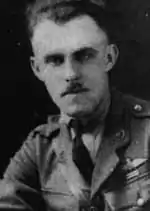William Carpenter Lambert
William C. (Bill) Lambert (August 18, 1894 – March 19, 1982) was an American fighter pilot who flew in World War I. He was probably the second-ranking American ace of World War I. He claimed 18 air-to-air victories, eight fewer than "Ace of Aces" Eddie Rickenbacker and was awarded the Distinguished Flying Cross.
William Carpenter Lambert | |
|---|---|
 William Carpenter Lambert, 1918 | |
| Nickname(s) | Bill |
| Born | August 18, 1894 Ironton, Ohio |
| Died | March 19, 1982 (aged 87) |
| Buried | Woodland Cemetery, Ironton, Ohio |
| Allegiance | |
| Service/ | Royal Air Force (United Kingdom) United States Air Force |
| Rank | Lieutenant Colonel |
| Unit | Royal Air Force |
| Battles/wars | World War I World War II |
| Awards | Distinguished Flying Cross |
Biography
He was born William Carpenter Lambert in Ironton, Ohio. He was the son of Mary and William G. Lambert.[1] Lambert had his first airplane flight in a Wright biplane on 4 July 1910.[2]
In 1914, Lambert quit his job as a chemist in Buffalo, New York, to go enlist in the Royal Regiment of Canadian Artillery. Finding no openings, he took a chemist's job with Canadian Explosives Limited until 1916. He joined the Royal Flying Corps in early 1917, and sailed for England after completion of his training, on 19 November 1917. He joined No. 24 Squadron RFC on 20 March 1918, flying the Royal Aircraft Factory SE.5a, where his teacher was top scoring irish-born ace George McElroy. Between April and August, scored 18 victories–one observation balloon and 11 aircraft destroyed (with two victories shared), and six driven down out of control (one of which was a shared victory).[3]
He was awarded the Distinguished Flying Cross.[4]
Suffering from combat fatigue brought on by a bombing attack on his airfield, he was rotated back to England for medical leave on 20 August 1918[1] but the war ended before he recovered.[2] One of his prized memorabilia was a piece of red canvas from von Richthofen's Fokker DR-1 triplane.
After the war, Lambert did some barnstorming in the Ironton, Ohio area and worked as an engineer. He also was the inventor of a rather unusual "pipe rest" which allowed a smoking pipe to be rested upon the smoker's chin.
Lambert joined the U.S. Air Service and served with the Army Air Forces in World War II. He retired in 1954 as a lieutenant colonel in the U.S. Air Force.
After World War, he was a frequent attendee at the RAF contingent's Battle of Britain celebration at Wright Patterson AF Base in Dayton, Ohio.
Lambert's wartime experiences were related in his 1973 memoir Combat Report.
He died in 1982 aged 87. He and his wife are buried in the Woodland Cemetery, Ironton, Ohio, in a mausoleum that he designed.
References
- "William Lambert". theaerodrome.com. Retrieved 10 April 2010.
- American Aces of World War 1. p. 36.
- Over the Front, p. 52.
- "William C. Lambert Royal Air Force Distinguished Flying Cross Orders". Ohio Memory Collection.
Bibliography
External links
- "William Carpenter Lambert". Find a Grave. Retrieved 2009-05-14.